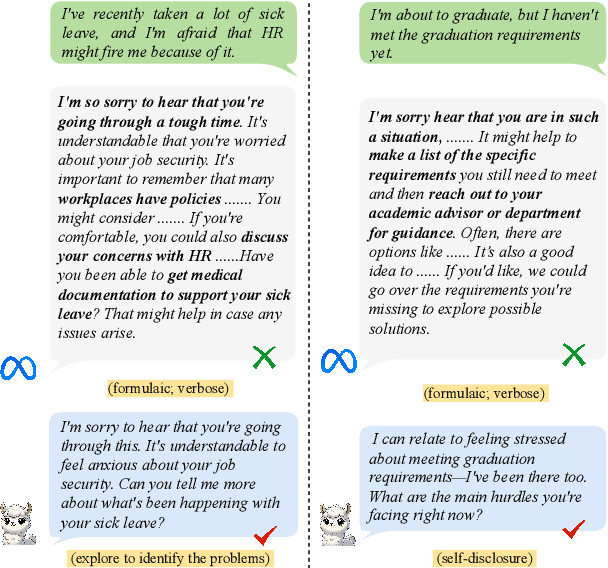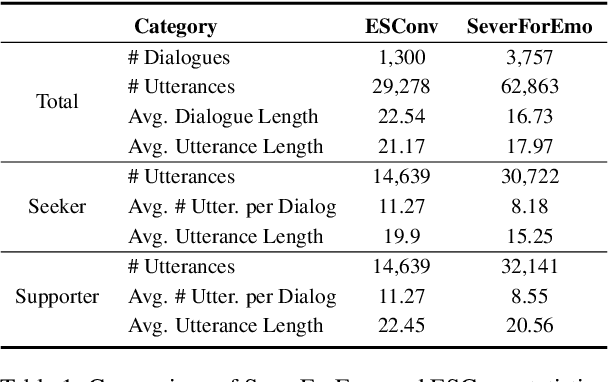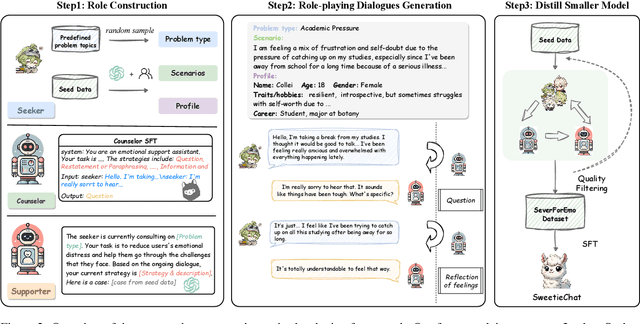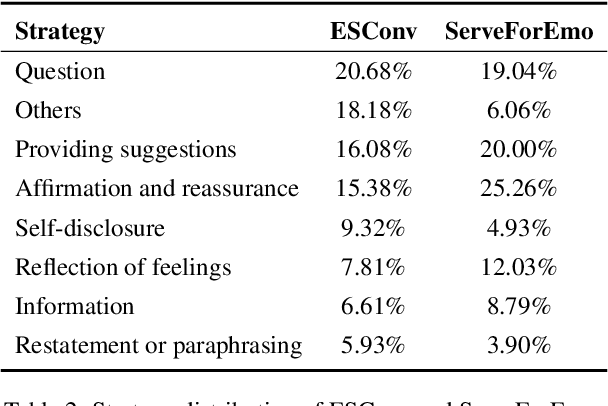Lu Xiang
National Laboratory of Pattern Recognition, Institute of Automation, CAS, Beijing, China, School of Artificial Intelligence, University of Chinese Academy of Sciences, Beijing, China
SweetieChat: A Strategy-Enhanced Role-playing Framework for Diverse Scenarios Handling Emotional Support Agent
Dec 11, 2024



Abstract:Large Language Models (LLMs) have demonstrated promising potential in providing empathetic support during interactions. However, their responses often become verbose or overly formulaic, failing to adequately address the diverse emotional support needs of real-world scenarios. To tackle this challenge, we propose an innovative strategy-enhanced role-playing framework, designed to simulate authentic emotional support conversations. Specifically, our approach unfolds in two steps: (1) Strategy-Enhanced Role-Playing Interactions, which involve three pivotal roles -- Seeker, Strategy Counselor, and Supporter -- engaging in diverse scenarios to emulate real-world interactions and promote a broader range of dialogues; and (2) Emotional Support Agent Training, achieved through fine-tuning LLMs using our specially constructed dataset. Within this framework, we develop the \textbf{ServeForEmo} dataset, comprising an extensive collection of 3.7K+ multi-turn dialogues and 62.8K+ utterances. We further present \textbf{SweetieChat}, an emotional support agent capable of handling diverse open-domain scenarios. Extensive experiments and human evaluations confirm the framework's effectiveness in enhancing emotional support, highlighting its unique ability to provide more nuanced and tailored assistance.
Context Injection Attacks on Large Language Models
May 30, 2024Abstract:Large Language Models (LLMs) such as ChatGPT and Llama-2 have become prevalent in real-world applications, exhibiting impressive text generation performance. LLMs are fundamentally developed from a scenario where the input data remains static and lacks a clear structure. To behave interactively over time, LLM-based chat systems must integrate additional contextual information (i.e., chat history) into their inputs, following a pre-defined structure. This paper identifies how such integration can expose LLMs to misleading context from untrusted sources and fail to differentiate between system and user inputs, allowing users to inject context. We present a systematic methodology for conducting context injection attacks aimed at eliciting disallowed responses by introducing fabricated context. This could lead to illegal actions, inappropriate content, or technology misuse. Our context fabrication strategies, acceptance elicitation and word anonymization, effectively create misleading contexts that can be structured with attacker-customized prompt templates, achieving injection through malicious user messages. Comprehensive evaluations on real-world LLMs such as ChatGPT and Llama-2 confirm the efficacy of the proposed attack with success rates reaching 97%. We also discuss potential countermeasures that can be adopted for attack detection and developing more secure models. Our findings provide insights into the challenges associated with the real-world deployment of LLMs for interactive and structured data scenarios.
Life-long Learning for Multilingual Neural Machine Translation with Knowledge Distillation
Dec 06, 2022Abstract:A common scenario of Multilingual Neural Machine Translation (MNMT) is that each translation task arrives in a sequential manner, and the training data of previous tasks is unavailable. In this scenario, the current methods suffer heavily from catastrophic forgetting (CF). To alleviate the CF, we investigate knowledge distillation based life-long learning methods. Specifically, in one-tomany scenario, we propose a multilingual distillation method to make the new model (student) jointly learn multilingual output from old model (teacher) and new task. In many-to one scenario, we find that direct distillation faces the extreme partial distillation problem, and we propose two different methods to address it: pseudo input distillation and reverse teacher distillation. The experimental results on twelve translation tasks show that the proposed methods can better consolidate the previous knowledge and sharply alleviate the CF.
Other Roles Matter! Enhancing Role-Oriented Dialogue Summarization via Role Interactions
May 26, 2022



Abstract:Role-oriented dialogue summarization is to generate summaries for different roles in the dialogue, e.g., merchants and consumers. Existing methods handle this task by summarizing each role's content separately and thus are prone to ignore the information from other roles. However, we believe that other roles' content could benefit the quality of summaries, such as the omitted information mentioned by other roles. Therefore, we propose a novel role interaction enhanced method for role-oriented dialogue summarization. It adopts cross attention and decoder self-attention interactions to interactively acquire other roles' critical information. The cross attention interaction aims to select other roles' critical dialogue utterances, while the decoder self-attention interaction aims to obtain key information from other roles' summaries. Experimental results have shown that our proposed method significantly outperforms strong baselines on two public role-oriented dialogue summarization datasets. Extensive analyses have demonstrated that other roles' content could help generate summaries with more complete semantics and correct topic structures.
CSDS: A Fine-Grained Chinese Dataset for Customer Service Dialogue Summarization
Sep 06, 2021



Abstract:Dialogue summarization has drawn much attention recently. Especially in the customer service domain, agents could use dialogue summaries to help boost their works by quickly knowing customer's issues and service progress. These applications require summaries to contain the perspective of a single speaker and have a clear topic flow structure, while neither are available in existing datasets. Therefore, in this paper, we introduce a novel Chinese dataset for Customer Service Dialogue Summarization (CSDS). CSDS improves the abstractive summaries in two aspects: (1) In addition to the overall summary for the whole dialogue, role-oriented summaries are also provided to acquire different speakers' viewpoints. (2) All the summaries sum up each topic separately, thus containing the topic-level structure of the dialogue. We define tasks in CSDS as generating the overall summary and different role-oriented summaries for a given dialogue. Next, we compare various summarization methods on CSDS, and experiment results show that existing methods are prone to generate redundant and incoherent summaries. Besides, the performance becomes much worse when analyzing the performance on role-oriented summaries and topic structures. We hope that this study could benchmark Chinese dialogue summarization and benefit further studies.
Augmenting Slot Values and Contexts for Spoken Language Understanding with Pretrained Models
Aug 19, 2021



Abstract:Spoken Language Understanding (SLU) is one essential step in building a dialogue system. Due to the expensive cost of obtaining the labeled data, SLU suffers from the data scarcity problem. Therefore, in this paper, we focus on data augmentation for slot filling task in SLU. To achieve that, we aim at generating more diverse data based on existing data. Specifically, we try to exploit the latent language knowledge from pretrained language models by finetuning them. We propose two strategies for finetuning process: value-based and context-based augmentation. Experimental results on two public SLU datasets have shown that compared with existing data augmentation methods, our proposed method can generate more diverse sentences and significantly improve the performance on SLU.
 Add to Chrome
Add to Chrome Add to Firefox
Add to Firefox Add to Edge
Add to Edge